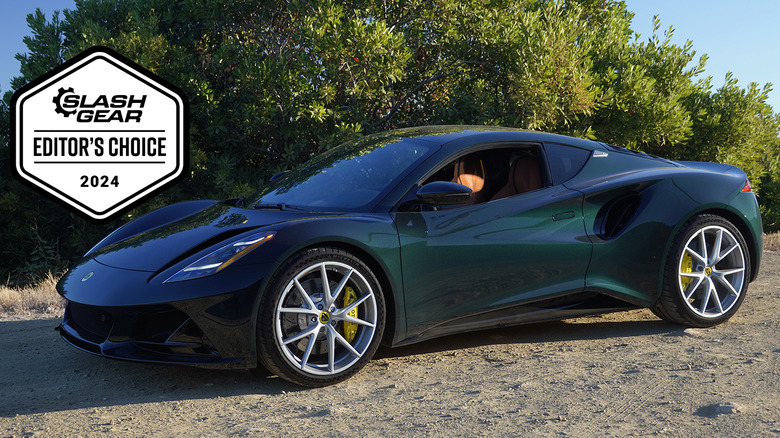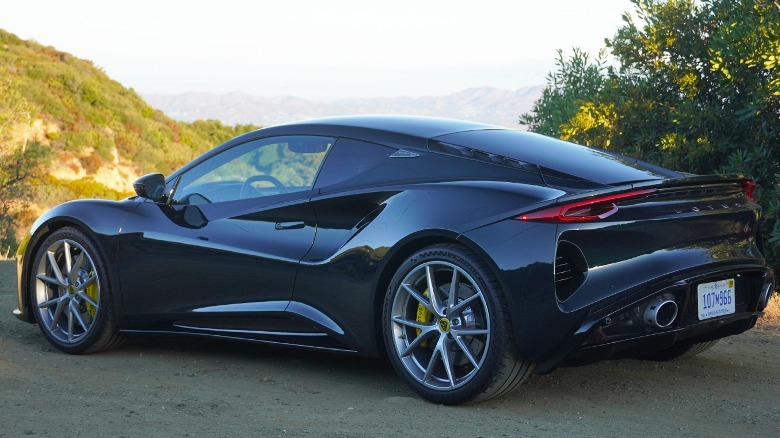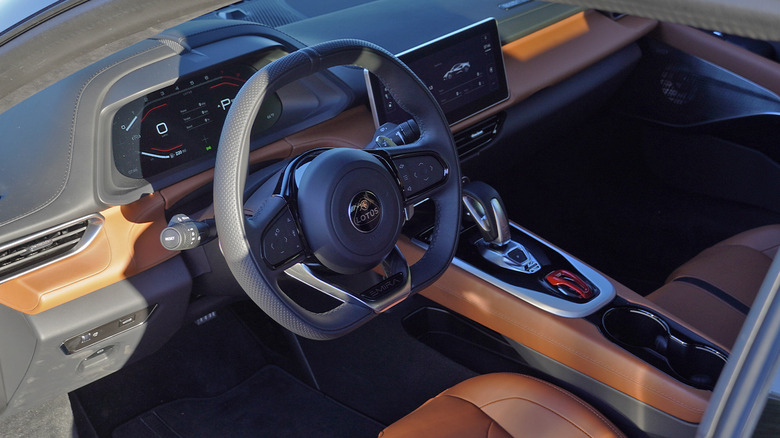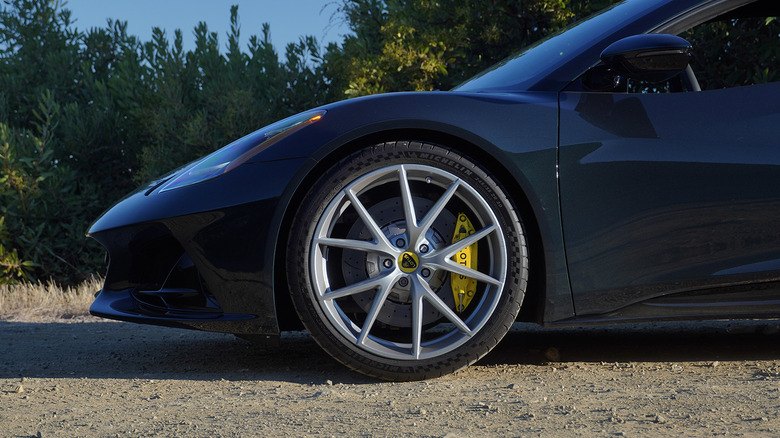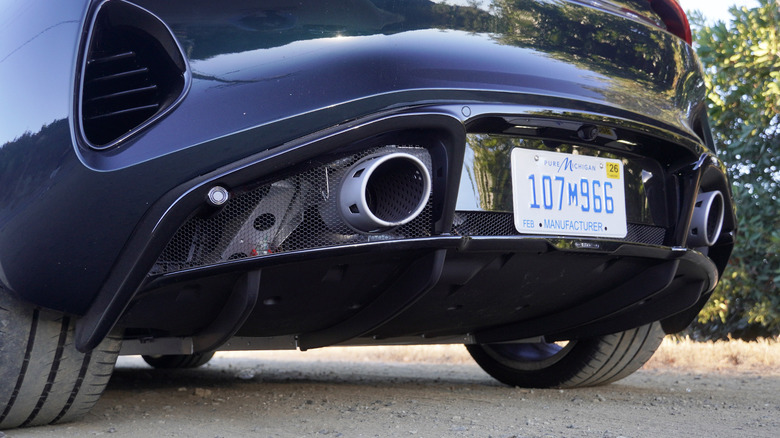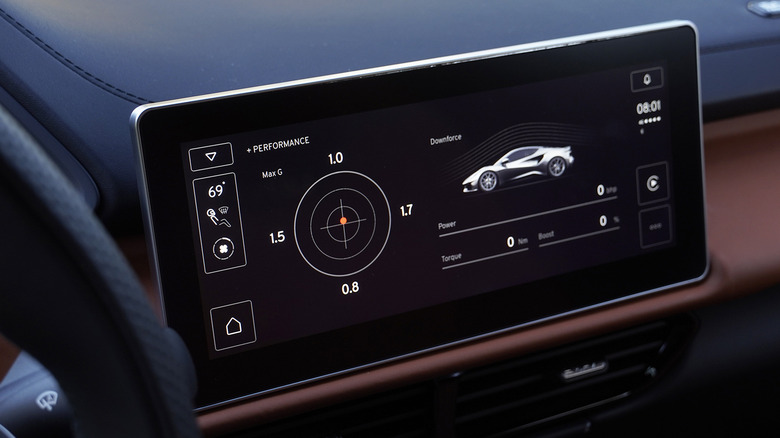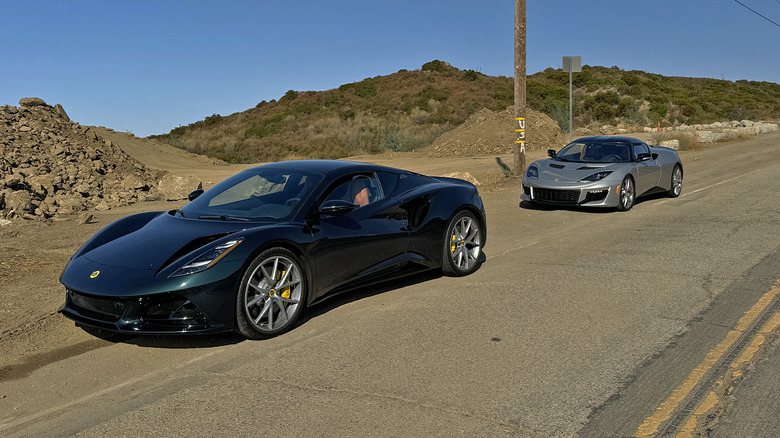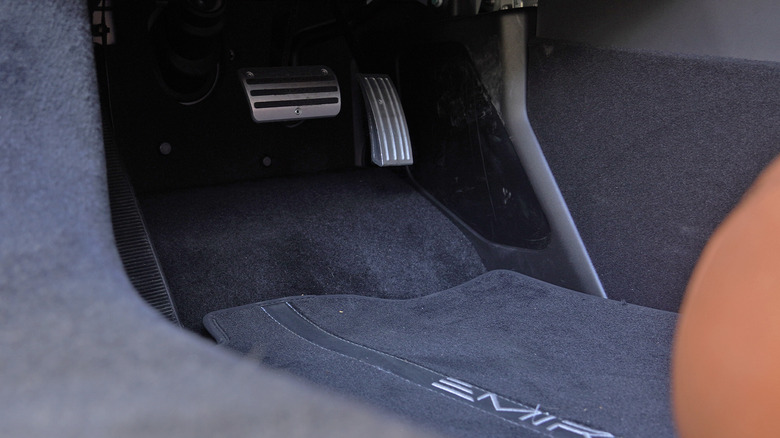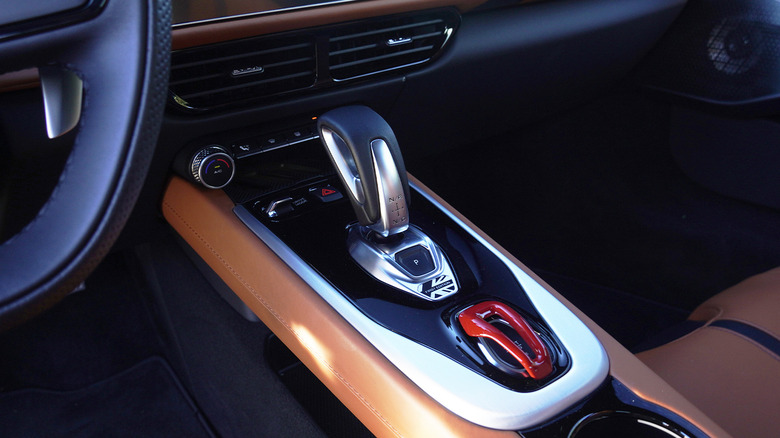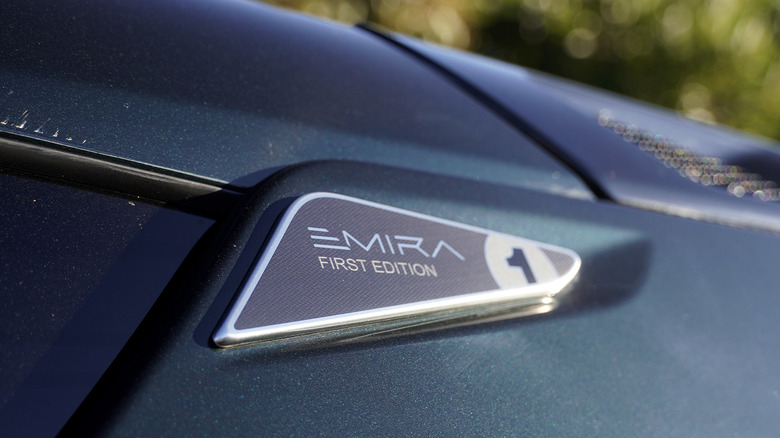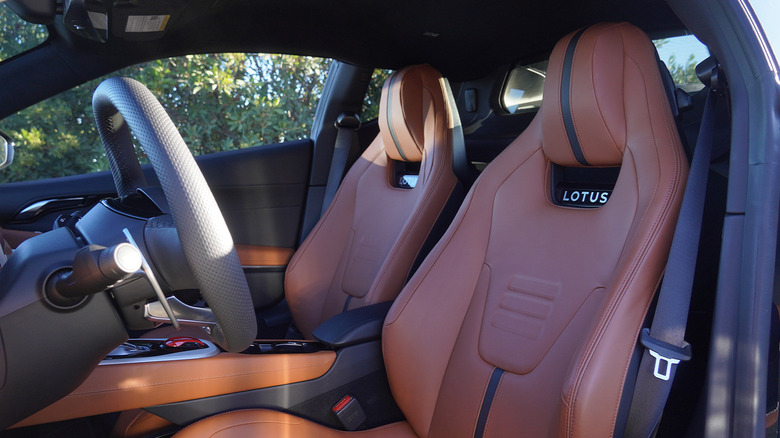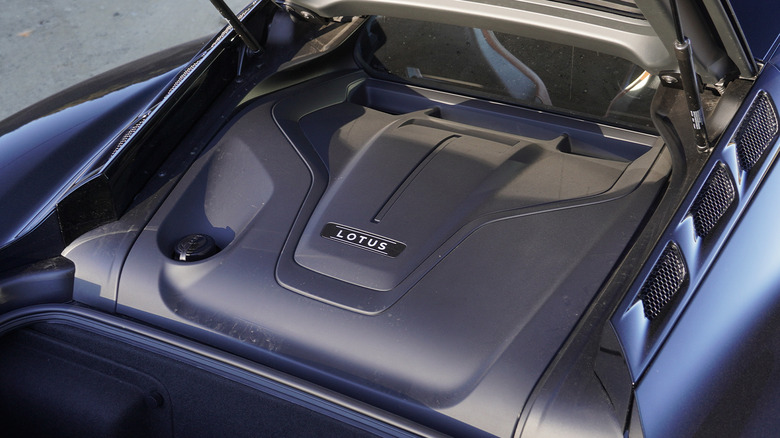2024 Lotus Emira 2.0 Turbo Review: AMG And DCT Deliver The Unthinkable
- Otherworldly handling unlike anything else on the market
- Stunning design, inside and out
- Firmer 'Sport' chassis somehow rides better in every scenario
- Still some fit and finish issues to iron out
- Engine and exhaust could be more spicy
- Dual-clutch gearbox shifts somewhat slowly
Anytime any automotive journalist dubiously proclaims that an automatic car might, just maybe, perhaps possibly, be better than the manual version, the skeptics cry out in defense. Heresy! Blasphemy! False! And normally, I count myself among the devotees of stick shifts and clutch pedals. But then I drove a Lotus Emira equipped with the AMG turbo-four and dual-clutch transmission. Compared to the Toyota V6-powered manual, almost inexplicably, I must admit the automatic is the better car. So please bear with me as I desperately attempt to explain the ineffable.
Now, we know that Lotus absolutely nailed the Emira's showroom appeal. The design looks good from every single angle, blending hints of modern McLaren and Ferrari styling in a smaller package that, once out on the road, simply shrinks in comparison to modern automotive behemoths. When I drove an Evora around Los Angeles, more than a few people pointedly asked, "What is that?" Now, the Emira establishes the new design language that will usher in the electric age at Lotus with a stunning mix of simplicity and exoticism.
The interior continues that simple and functional theme but also adds noticeable touches of class and luxury. Without a doubt, the Emira exists in that rarefied air where anticipation built up among enthusiasts for years, and a lingering curiosity still exists now for those who spot cars finally in the hands of customers (just don't ask about the emissions snafu that led to dozens left stranded in San Pedro for a year plus). Will the Emira go down in history as the final road-legal internal-combustion car from Lotus? With the Evija and Eletre EVs on the market, at the very least, the Emira looks likely to wind up as the last Lotus from the Lotus we used to know and love.
Double down on the differences
The Emira shares a lot with the Evora, as countless reviews explain ad infinitum. And yet when I drove an early build with the supercharged Toyota V6 and manual, I immediately recognized the development gap—in sheer years and technological prowess—between the two cars. From the jump, the Emira's wider chassis, with more space inside, emphasizes the composed suspension and quieter cockpit, which then wakes up to a new performance level (even if the V6 counterintuitively puts out less power than in the final Evora GT variant).
Now, driving the Emira 2.0—or Turbo, whatever you want to call it—Lotus levels up again. The build quality markedly improved in 18 months, with more uniform panel gaps and interior stitching and fewer creaks and rattles and trim pieces looking somehow off. The more modern DCT shifter, rather than the same manual lever and ball carrying over since at least all the way back on the Elise, helps to reinforce that impression further. And even on a first cruise around the neighborhood, I sensed the increased refinement of this Sport package, which somehow wound up both better planted and firmer than the Tour, yet also more compliant and comfortable. Only the worst roads upset the stiffer springs and dampers, causing a bit of chop and porpoising.
Those early intimations started to build up that old urge, that this kind of car simply cannot suffice as a daily driver alone. Time, then, to hit the canyons ASAP as possible. So the very next morning, I headed up to the familiar roads of Malibu with a friend in his G80 BMW M3 Competition looming large in my tiny rearview mirror.
Up into the Emira's natural habitat
The Michelin Pilot Sport Cup 2 tires that come standard with the Emira's Sport package needed a moment to warm up on a cold and cloudy morning, but once up to temp, good gracious. Though we never started ripping as quickly as legit supercars on the straightaways—or motorcycles, or even an Audi RS 3, really—the AMG engine puts out just the right amount of power for public roads. Plus, the four-banger still allows that building sensation of boost as torque swells to a healthy 354 lb-ft, rather than the flattened torque curves that so many automakers strive to achieve with electronically controlled wastegates and miniature air pumps and other fancy anti-lag systems (mostly looking at you, Subaru).
Yet in this application, in the lightest car I've driven with this AMG engine by a good amount, a bit of spice seemed left off the top end. Mercedes detuned the package, trimming 16 horsepower. But even in Sport mode, with the exhaust valving opened up a bit, the burble and runoff pops mostly just sound okay, though cracking the windows allows in highlights of some turbo spooling and blowoff rush.
The transmission also lags a bit, shifting slightly slower than I remember from other Benzes—and certainly not as snappily as other high-performance dual-clutches. The smoother shifts probably work well for daily commuting, certainly a consideration for the automatic Emira, but while pushing hard, I found myself hitting fuel cutoff more than a few times until I started popping the right paddle at least 800 RPM before redline.
Pushing hard for g-meter readings
Oh well, straightline speed isn't really the point here; this is a Lotus, after all. So I resigned myself to the chore of pulling up the g-force accelerometer readout and setting some world records. Two different gauge cluster layouts both place the tachometer at the top of the display, which at my 6'1" height caused the steering wheel to block out the rev counter unless I scooted the column up a few inches higher than I typically prefer. But a g meter visible on either the instrument cluster or larger touchscreen left no doubt as to the Emira's cornering prowess.
The numbers refresh after every power cycle, yet already read 0.9 g on both sides before I even got out of my neighborhood. That's the kind of handling most cars never achieve ever, but the Emira still had so much more to give. On the first climb up Las Flores Canyon to Saddle Peak, I got up to 1.2 g, then 1.3 on a long right sweeper. Headed back down Stunt, I needed to push the brakes harder, set the nose better to maximize that Sport suspension. There I found the shoulders of the Cup 2s, now fully hot and steaming, ready for max turn-in. Oh yes, try for a few of those, fully focused on holding the best line—as only small and narrow sports cars can any more on canyon roads.
New high score, did I break it?
Back out onto a longer straight, then check the screen. First I got up to 1.5 on another right-hander, matching my high score from the manual Emira. Then, after cranking through a tight left, I spied 1.7 g on the display—the best number I've ever achieved in any car on public roads, and without any banking on the corner, either. Not bad, Emira 2.0, not bad. Time to head home, ego needs fulfilled (and maybe post a pic to tease all my competitive journalist friends).
But egoistic fulfillment only lasts so long, and soon enough, the junkie in me needed more. And better, since this time I ditched the BMW bro in favor of a friend who just happens to own a 2017 Evora 400. The 400 preceded the final years of the Evora GT that I previously drove, and as the nomenclature suggests, the supercharged Toyota V6 in this case put out 400 horsepower—the same figure as the AMG engine in the Emira Turbo. More importantly, though, the Evora 400's suspension rides a bit softer, in similar fashion to the Tour versus Sport debate for the Emira.
We cruised up the Pacific Coast Highway, me watching the tiny Evora occupying much less of my rearview mirror than that beastly BMW, the roofline noticeably narrower than my Emira and that mean lower rectangular grille reading as almost pitch black on another misty morning. Yet the Evora's headlights seem so primitive in hindsight (literally) and overall, the design fails to coalesce in comparison to the Emira. We pull off in Malibu to do a little lookyloo and he offers to let me drive a quick lap in support of my career choices. Heck yes, thanks boss.
Emira meets Evora
In such close proximity, rather than years apart, the stark generational gap between Evora and Emira stands out even more. Obviously, one harks from a different era of automotive technology, with hilariously outdated and pixelated digital gauges, not to mention that ridiculous aftermarket head unit. But the Evora 400's manual seats also ride maybe an inch or two higher, so the driver's position scooches forward somehow, which only emphasizes the reduced interior volume.
The absurdity of a backseat might contribute to the hunch that I need to hunch forward to keep from brushing my hair on the double-bubble roof. But this steering wheel in my hand brings back memories. This shifter, this specific shifter in fact, somehow works best of any Lotus yet—maybe any car yet, bar the Inokinetic 111RS custom piece that defies physics. Then I find the minuscule clutch pedal, feel for the matching brake, and locate the cramped accelerator. I remembered the Evora lacking a dead pedal, another reminder of the imperfection of eyewitness testimony.
We get up to a bit of pace, though of course I drive much more responsibly and respectfully in a privately owned vehicle than a press fleet test unit. And the Evora lacks a g meter, which inspires fewer egotistical bouts of buffoonery trying to set high scores. Instead, I find myself exploring throttle response more, where the V6 transitions from muted lugging into sufficient supercharger boost above about 4,500 RPM. I push the exhaust button above the touchscreen, and hear a bit more roar to cover up the road hum echoing through the cockpit.
Evora 400 vs GT: unreliable eyewitness testimony
The six-speed's ratios match Yerba Buena and Mulholland perfectly, as I stick mostly to second and third. But the chassis simply exists on a different planet. I might not ever set the same cornering load or match the Emira's sheer pace, but the Evora communicates more throughout this quick session—despite the PS4S tires, not bad rubber but hard to step back to after Cup 2s on a day that quickly warms up to a scorcher.
The Evora and I both need a moment to warm up, too. Unlike the Emira, I can't just climb in and set world records. I need to learn how to work with the car, allowing a bit more time for the brakes to bite down, a bit more finesse before the front tires compress, earlier reapplication of throttle coming through apex. We're in automotive Eden, empty roads and tight corners and clouds burning off above the chaparral. The exact situation that Lotus dreamed of for this exact car. I only learn more about the differences between Evora 400 and GT later, but back in reality on the PCH looping back to the Emira, I point out how much more comfortable this car rides than I recalled from taking the GT out on this exact same road. Sure enough, I can now say that trading 16 ponies for superior suspension now leaves the 400 at the top of my favorite Evoras list. In dark green over a black interior, obviously.
Back to the future
Back in the Emira again, the first thing my by-now-bedraggled brain brings up? Just the torque difference of the AMG turbo's low-end boost. Then I start to miss the supercharger's mechanical bypass valve visible in the rearview mirror (why on Earth did Lotus cover up the AMG engine entirely?). I also do prefer to ride a bit lower, though the Emira's electric adjustment buttons left me pining for the Evora's manual seats. Something about the analog joy of finding that perfect position—yet that minor difference contrasts starkly with how much I do love pulling up Waze on wireless Apple CarPlay to keep an eye out for cops.
Of course, the Emira is still a Lotus so the passenger door creaks regularly, if not quite as bad as the Evora. The touchscreen also doesn't line up quite perfectly with the dash stitching directly below. And the modern shifter that looks so good functions absolutely ridiculously, requiring a double push forward for reverse and twice rearward for drive, with enough latency that I never manage to get it right the first or second try.
Driving home, Evora-versus-Emira debates against Emira-versus-Emira-2.0. I wind up wishing for more of a controlled experiment, to compare the AMG-DCT combo against the V6-manual with the same Sport (not Tour!) chassis. Because this is the AMG turbo-four with 400 horsepower, a dual-clutch, stiffer springs, and Cup 2 tires, while that is the Toyota V6 with a supercharger and a manual and softer springs and terrible Goodyear garbagio tires.
Spiraling out on borderline supercars
The differences set my mind into a tailspin of questions without answers. That Emira V6 was an early build, has Lotus just gotten better at production over the interim years? Perhaps the differences in springs and tires makes up for more than I imagined? And yet, this Emira rides better in every scenario, not just at the edge of performance. Then again, the Cup 2 tires provide so much more grip than the Goodyears while pushing, but on other cars, typically seem a bit less communicative because Michelin clearly prioritized all-out performance and not necessarily driver feedback.
Perhaps more in-depth mechanical differences come into play. Do the engine and transmission mounting locations vary enough between AMG–DCT and V6-manual to provide better chassis balance? How much does the polar moment of inertia contrast between the two powertrains? This Emira 2.0 just feels altogether more cohesive, more buttoned-down. It's a better car, without a doubt.
I begin to suspect that Lotus engineers developed this car, specifically, first. Firmer springs but with a bit more give from the dampers; hydraulic steering dialed in for the modern buyer; the wider track and Cup 2 tires... Then a bean counter from the accounting department hollered, "We need a softer touring version! For the Customers!" Et voilà, the Tour, an afterthought sibling that received less attention, less care. Nature versus nurture—the Tour can only compensate for my hypothetical last-minute development revisions so much. And the Sport, on the other hand, with the AMG powertrain that helps make the Emira more of an evolutionary leap forward from the Evora, rather than just a small step.
Only one competitor, in reality
And no amount of internal squabbling can ignore the only other car an Emira of any kind compares to, in terms of performance but also pricing. This Emira 2.0 First Edition starts at $99,900 for a reason: Porsche currently lists the 718 Cayman GTS 4.0 at $99,700. But that flat-six revs to 8,000! And the six-speed rocks! So yes, I would still take the GTS 4.0, even if the design, inside and out, hails from a previous generation. Porsche reliability fits into the conversation, too, after all.
But the Emira 2.0 steps up above a Cayman GTS 4.0 with the PDK, though, I surprise myself by concluding in a fit of transcendental realization—not quite ego death, I suppose, since we're still talking about inexcusably expensive modes of transportation. Of course, I'd still go out and buy a 996 Turbo instead, but my apologies for the simple fact that you can't expect rational thought in this conversation.
What comes next
Then I start to swirl in the murky waters of tuning the AMG engine for a bit more power, the confusion of other markets receiving an SE and First Edition with different output ratings, and how the GT4 version fares in track work. Almost more importantly, an aftermarket exhaust system might open up the turbo-four while helping with the gruff soundtrack that somehow lacks the requisite depth, almost all of the time, to substantiate a borderline six-figure borderline supercar such as this. Or maybe some snappier gearshifts with some kind of a transmission controller device.
Then, of course, the prospect of the AMG engine paired to a manual rears up. Surely some Mercedes gearbox bolts right on, after all? Now step up into the 450-horsepower range, with a few pounds trimmed off the Sport chassis. Hopefully, Lotus plans to put out such a potent package at some future date. Or maybe even shoehorn a little AMG 4.0-liter V8 (the gas half of new hybrids like the S63 E-Performance) into that tiny engine bay—which would help to further explain the Emira's lack of rear seats. And explain the investment required to develop a new car for such an admittedly short lifecycle. Because now we're talking about a Lotus worthy enough to close out the company's internal-combustion era in proper fashion.
